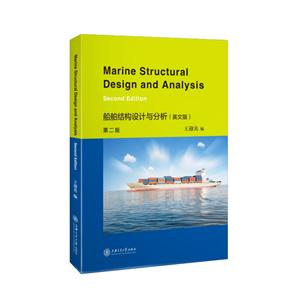扫一扫
关注中图网
官方微博
本类五星书更多>
-
>
湖南省志(1978-2002)?铁路志
-
>
公路车宝典(ZINN的公路车维修与保养秘籍)
-
>
晶体管电路设计(下)
-
>
基于个性化设计策略的智能交通系统关键技术
-
>
德国克虏伯与晚清火:贸易与仿制模式下的技术转移
-
>
花样百出:贵州少数民族图案填色
-
>
识木:全球220种木材图鉴
船舶结构设计与分析(英文版 第2版) 版权信息
- ISBN:9787313235015
- 条形码:9787313235015 ; 978-7-313-23501-5
- 装帧:一般胶版纸
- 册数:暂无
- 重量:暂无
- 所属分类:>>
船舶结构设计与分析(英文版 第2版) 内容简介
《船舶与海洋结构物结构设计与分析》的特点是概念阐述简明清晰,理论推导严密详尽,并穿插配合工程应用实例说明,目的是使学生通过工程应用实例来加深对船舶与海洋结构物结构设计与分析基本原理和基本概念的理解,以期收到事半功倍的效果。??《船舶与海洋结构物结构设计与分析》的重点是以结构静力学和动力学为基础,研究船舶与海洋结构物结构设计与分析的外载荷计算、结构动力响应、结构规范设计、结构直接计算法设计等。
船舶结构设计与分析(英文版 第2版) 目录
Chapter 1 Introduction to marine structural design
1.1 The traditional design method
1.1.1 The evolutionary process
1.1.2 A ship structural design example
1.1.3 The changes to the traditional design method
1.2 The modern design method
1.2.1 The first-principles-based approach
1.2.2 The design procedure
1.2.3 Benefits of the modem approach
Chapter 2 Marine structural design fundamentals
2.1 Structural arrangement design
2.1.1 Subdivision arrangement
2.1.2 Compartment arrangement
2.1.3 Access arrangement
2.2 Structural materials
2.2.1 Introduction to materials
2.2.2 Standard steels used for hull and other structure
2.2.3 High strength steel used for hull and other structures
2.2.4 Selection for steel grades
2.2.5 Other ship materials
2.2.6 An example of ship materials used for a dredging barge
2.3 Welding
2.3.1 The base types of welding joints
2.3.2 The base types of welding line
2.3.3 Stud welding
2.3.4 The determination of the weld size
2.3.5 A welding design example
2.4 Classification societies and their rules
2.4.1 Classification societies
2.4.2 Class rules, regulations and guides
Chapter 3 Loads and loads combinations
3.1 Environmental considerations
3.2 Loads
3.2.1 Static loads
3.2.2 The wave induced loads
3.2.3 The hydrodynamic loads
3.2.4 The sloshing loads
3.2.5 The impact loads
3.2.6 Other loads types
3.3 Loads combinations
3.4 Strength modeling and development of strength criteria
Chapter 4 Marine structural initial design
4.1 Hull girder strength and sheafing strength
4.2 Hull structural members design
4.2.1 Hating design
4.2.2 Longitudinals and girders design
4.2.3 Bulkhead design
4.3 An example of hull structural members design-pillar design
4.3.1 Basic design of pillars
4.3.2 Some requirements for the pillars in rules
4.3.3 Regulations of pillars on different types of ships
4.4 Superstructure design
4.4.1 The interaction between the superstructure and the main hull
4.4.2 The design of superstructures
4.4.3 The failure of superstructures and prevention measures
4.5 Introduction to structures of various kinds of ships
4.5.1 Oil tankers
4.5.2 Bulk carriers
4.5.3 Container ships
Chapter 5 Marine structural design analysis
5.1 Total strength assessment
5.1.1 Yielding strength
5.1.2 Buckling and ultimate strength
5.1.3 Fatigue strength
5.2 Strength criteria
5.2.1 General introduction
5.2.2 Yielding criteria
5.2.3 Buckling and ultimate strength criteria
5.2.4 Fatigue criteria
5.3 Finite element analysis
5.3.1 The developmental history of the finite element analysis
5.3.2 The basic idea of the finite element method
5.3.3 A finite element analysis example -- a 75,000 DWT bulk carrier
5.4 Spectral fatigue analysis of ship structures
5.5 The transverse strength analysis of a ship
5.5.1 Setting the design load
5.5.2 Simplification of members' geometry size
5.5.3 Simplification of the frame supporting conditions
5.5.4 Modeling the structure processing
5.5.5 Modeling the loads
5.5.6 Building the finite element model for the ship structures
Chapter 6 Marine structural design optimization
6.1 The introduction to the optimization
6.2 The categorization methods for optimization problems
6.2.1 Continuous versus discrete optimization
6.2.2 Constrained and unconstrained optimization
6.2.3 Global and local optimization
6.2.4 Deterministic and stochastic optimization
6.3 An example--the optimization of stiffened panels
6.3.1 Introduction to stiffened plates
6.3.2 The numerical solution method for a stiffened panel
6.3.3 Summarization
6.4 Another example--the optimization of a T-bar
6.4.1 The problem raised and the model established
6.4.2 Analytical solution method
6.4.3 Finite element analysis solution method
6.4.4 Comments on each solution method
References
展开全部
船舶结构设计与分析(英文版 第2版) 作者简介
王迎光:上海交通大学硕士导师,长期从事海洋工程随机结构动力学; 船舶非线性动力学; 船舶结构优化设计研究。
书友推荐
- >
中国历史的瞬间
中国历史的瞬间
¥16.7¥38.0 - >
朝闻道
朝闻道
¥16.7¥23.8 - >
回忆爱玛侬
回忆爱玛侬
¥10.5¥32.8 - >
伊索寓言-世界文学名著典藏-全译本
伊索寓言-世界文学名著典藏-全译本
¥6.1¥19.0 - >
企鹅口袋书系列·伟大的思想20:论自然选择(英汉双语)
企鹅口袋书系列·伟大的思想20:论自然选择(英汉双语)
¥9.7¥14.0 - >
我从未如此眷恋人间
我从未如此眷恋人间
¥16.4¥49.8 - >
唐代进士录
唐代进士录
¥17.1¥39.8 - >
推拿
推拿
¥12.2¥32.0
本类畅销
-
船舶动力装置概论
¥10.5¥22 -
船检文化
¥27¥50 -
港口文化
¥30.4¥60 -
4.23文创礼盒A款--“作家言我精神状态”
¥42.3¥206 -
4.23文创礼盒B款--“作家言我精神状态”
¥42.3¥206 -
一句顶一万句 (印签版)
¥40.4¥68




















